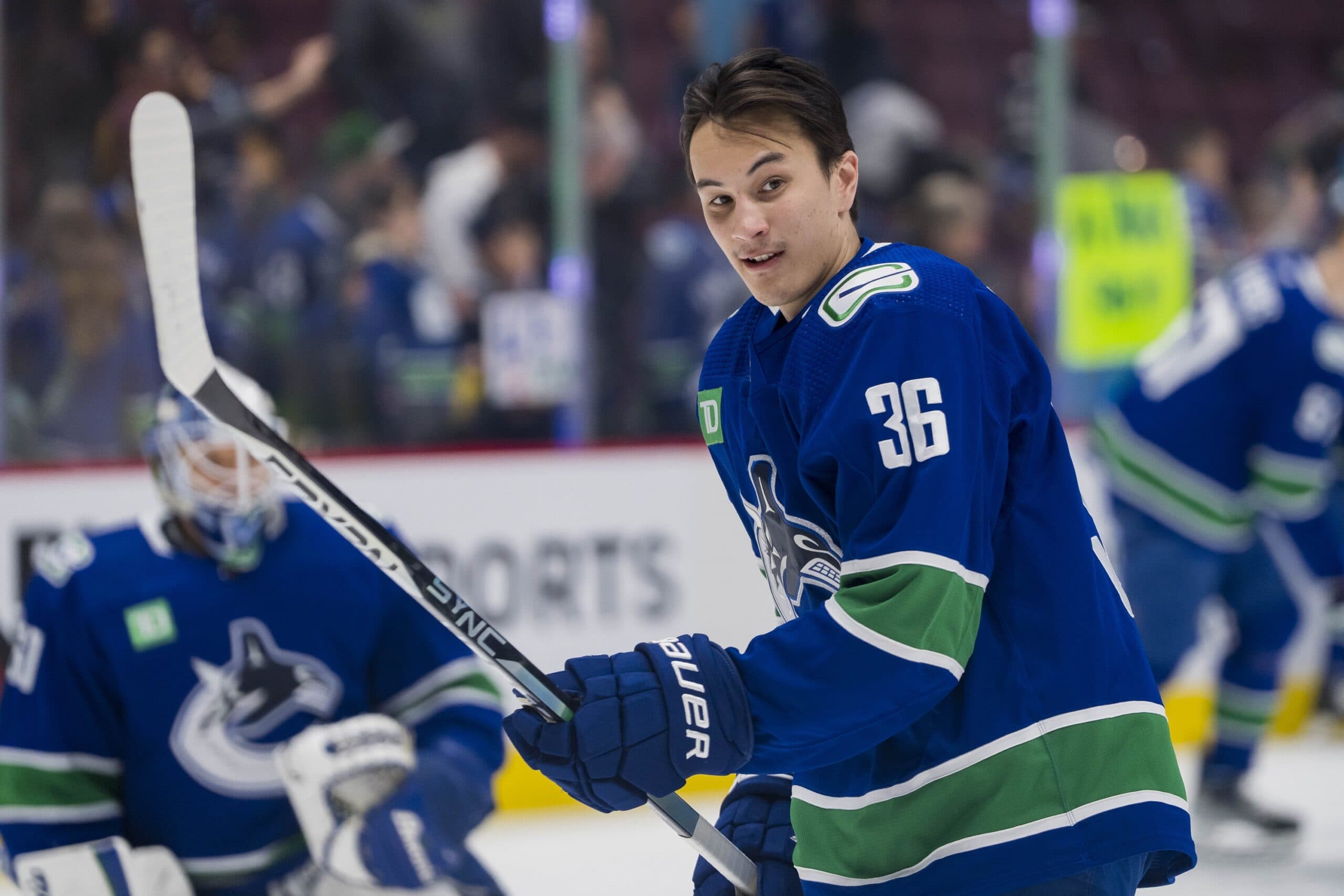There’s little argument among the local fanbase or mediasphere that the Vancouver Canucks’ prospect situation has dramatically improved ever since GM Patrik Allvin and Co. took over the front office.
Not that the bar left behind for them to clear was particularly high.
Unfortunately, the nature and timing of the 2023 Penticton Young Stars Tournament means that not all of the Canucks’ restocked cupboard is on display this weekend. Based on our own Faber’s official CanucksArmy prospect rankings, the Penticton Canucks are without four of their top-five prospects in Tom Willander (NCAA), Jonathan Lekkerimäki (SHL), Elias Pettersson 2.0 (SHL), and Arturs Silovs (too cool for this tourney).
Other notable prospects like Lucas Forsell and Linus Karlsson are also absent.
And yet, one can look at the four rosters assembled by the participants in the Young Stars tournament and see that the Canucks’ is easily the best of the bunch. How is that possible, with so much missing from the top-end?
Simple. It’s called prospect depth, and it’s something the Canucks haven’t had in a long, long time.
We don’t need to spend an excessive amount of time reliving the past here. The Jim Benning Era is over, and everyone is mostly happy to move on with eyes forward. But we’ll fall back into it here for the purposes of highlighting the abundance of attention that was given to Benning’s high-profile draft busts, when what really sunk him as a future-building GM was a total inability to add depth throughout the organization.
In Benning’s eight drafts at the helm, the Canucks drafted a grand total of two players beyond the first round who can be said to have gone on to play a significant role in the NHL. Those players are Thatcher Demko, who was drafted 36th overall in Benning’s first draft, and Gustav Forsling, picked 90 picks later in the same year. Forsling was, of course, famously traded away before ever playing a game with the Canucks.
In the seven drafts following that, the post-first-round success rate is an even 0%, though we’ll note that several (Silovs, Forsell, Nils Höglander, Aidan McDonough, Danila Klimovich) still have an open chance to change that.
Still, any way you slice it, it’s a shockingly low amount of talent capital gleaned from an awful lot of draft rounds in which the Canucks were slotted highly. Compounding that issue is the fact that the Canucks only managed to sign two undrafted free agents of note during that same timeframe: Troy Stecher and Zack MacEwen, both mild successes at best as far as the Canucks are concerned.
Now, we don’t want to put the cart before the horse here. But the sheer amount of prospects who appear to have a genuine chance at one day playing some NHL minutes on display in Penticton right now has to stand in stark contrast to the cupboard that was produced by all the Benning years combined.
Even with four of the top-five missing, you’ve got Klimovich, McDonough, Aatu Raty, Hunter Brzustewicz, Sawyer Mynio; all drafted prospects with widely-recognized NHL potential. And on top of those players, you’ve also got a legitimate abundance of clever undrafted free agent signings that push the Canucks’ cupboard from just good to good and deep.
Akito Hirose and Cole McWard might be the two best players on the ice at any given time. Filip Johansson has warts, but also all of the skill that once made him a first round draftee. Arshdeep Bains continues to impress. Nikita Tolopilo looks like Ian Clark’s next passion project. Max Sasson seems to have more upward potential than anyone gave him credit for.
It’s a set of acquired-for-free players that goes along nicely with similar talents already added to the organization in the likes of Andrei Kuzmenko, Nils Åman, and Karlsson. It’s just a lot of hockey stock added to the books for the cost of zero draft picks and zero assets, and it’s hard not to see it as a difference-maker in the long-term.
We’re not here to claim that all of these players are going to make an impact at the NHL level. In fact, we’ll go as far as to say that a lot of them won’t. That’s just the reality of being a prospect. But what Allvin and Co. have done a much, much better job of than the previous regime is exactly what we said at the outset: adding depth throughout the organizational chart.
All prospects are lottery tickets, but those drafted outside the top-32 should be thought of especially in that way. As in, the only way to really guarantee a win on any of them is to have a whole handful. It’s an abundance thing, where each individual prospect only has a certain chance of making an impact, but the odds of at least one of them making an impact increases the more individuals a team has on hand.
And the Canucks now have far more individuals who might make an impact on hand than they ever have before. A good chunk of them are in Penticton right now, beating the wheels off of other Western Canadian Young Stars.
That doesn’t necessarily translate into the Adult Canucks beating the Flames, Oilers, and Jets on a consistent basis from here on out. But it should translate into the Canucks being able to continuously inject youth into all segments of their rosters for years to come, and that will allow them to sustain any level of success they’re able to achieve at the NHL level.
Ironically enough, it doesn’t take much deep thought to determine that more depth is good. But knowing and doing are two different things. This current iteration of the Canucks is doing depth better than any in recent memory.
And that’s undoubtedly a net-positive for the franchise.


